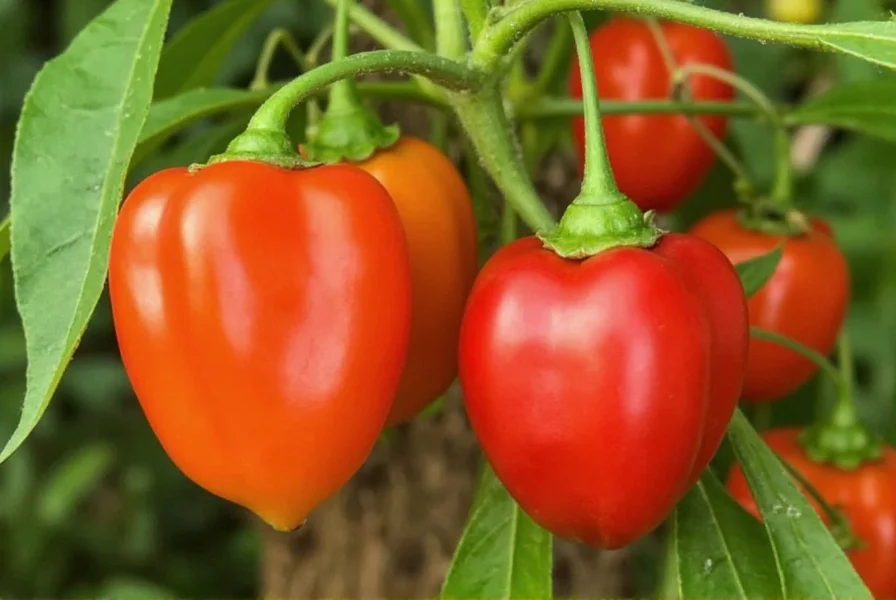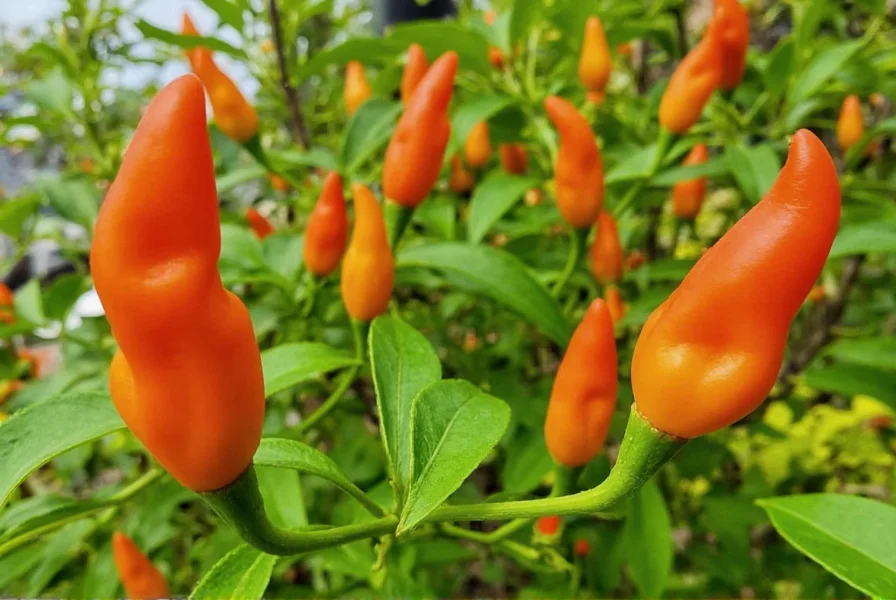Chiltepin peppers (Capsicum annuum glabriusculum), also known as bird peppers, are wild chili peppers native to the southwestern United States, Mexico, and Central America. Often called the 'mother of all chili peppers,' they're the ancestors of many cultivated varieties. With a Scoville rating of 50,000–100,000 SHU, they pack intense heat and smoky flavor, making them a favorite among spice lovers and chefs.
Table of Contents
What Is Chiltepin Pepper?
Chiltepin peppers (Capsicum annuum glabriusculum) are the wild ancestors of many domesticated chili peppers. These small, marble-sized peppers grow naturally in dry, rocky areas and are known for their intense heat and complex flavor profile. Unlike cultivated varieties, chiltepins are perennial in warm climates and thrive in USDA zones 9–11.
How Hot Is It?
Don't let their tiny size fool you — chiltepins bring serious heat! With Scoville Heat Units (SHU) ranging between 50,000 and 100,000, they fall into the same heat range as cayenne and Thai chilies. That means they're significantly hotter than jalapeños (2,500–8,000 SHU), but not quite as searing as habaneros (100,000–350,000 SHU).
| Pepper Type | Heat Level (SHU) | Flavor Profile |
|---|---|---|
| Chiltepin | 50,000–100,000 | Smoky, fruity, earthy |
| Jalapeño | 2,500–8,000 | Grassy, vegetal |
| Thai Chili | 50,000–100,000 | Sharp, citrusy |
| Habanero | 100,000–350,000 | Fruity, floral |
| Cayenne | 30,000–50,000 | Earthy, pungent |
Because of their intense flavor and heat, a little goes a long way. Whether you're making salsas, hot sauces, or simply drying them for seasoning, a few crushed chiltepins can transform any dish into a spicy masterpiece.
Growing Tips for Home Gardeners
Thinking about growing chiltepins in your garden? Here are practical tips to get you started:
- Climate: Thrives in USDA hardiness zones 9–11, but can be grown indoors or in greenhouses in cooler regions.
- Soil: Well-draining soil is essential. Mix in sand or perlite if your soil retains moisture.
- Sunlight: Requires at least 6–8 hours of full sun daily for optimal growth.
- Watering: Once established, they're drought-tolerant. Water deeply but infrequently to encourage strong roots.
- Propagation: Seeds benefit from overnight soaking and consistent warmth (80°F / 27°C) for better germination.
These plants attract birds — which is natural since birds are immune to capsaicin and help disperse seeds.
How to Use Chiltepins in the Kitchen
Chiltepins have a bold, smoky flavor profile perfect for various dishes:
- Salsas: Crushed dried chiltepins add depth and fire to fresh tomato or mango salsas.
- Hot Sauces: Combine dried chiltepins with vinegar, garlic, and honey for complex condiments.
- Meat Rubs: Mix ground chiltepins with salt, smoked paprika, and cumin for grilled steaks or roasted pork.
- Infused Oils: Steep dried chiltepins in olive oil for versatile cooking oil with heat.
- Pickling: Whole chiltepins can be pickled for brines or vinegars.
| Product Type | Target Audience | Best For | Recommended Occasions |
|---|---|---|---|
| Dried Chiltepins | Chefs, home cooks, spice lovers | Cooking, flavor enhancement | Summer grilling, holiday dishes |
| Fresh Chiltepins | Culinarians, DIY sauce makers | Fermentation, pickling, raw use | Farm-to-table meals, artisan recipes |
| Live Plants | Gardeners, permaculture enthusiasts | Home cultivation, biodiversity | Spring planting, landscape design |
| Seeds | Growers, researchers, hobbyists | Propagation, breeding projects | Educational purposes, experimental farming |
Bonus tip: Always wear gloves when handling fresh chiltepins to avoid skin irritation.
Buying Guide: Where to Find and How to Choose
Where to Buy
- Farmers' Markets: Especially in the Southwest U.S., local growers sell fresh or dried chiltepins during late summer and early fall.
- Online Spice Retailers: Specialty shops offer dried whole or ground chiltepins. Look for organic, sustainably sourced options.
- Gardening Nurseries: Some nurseries carry live chiltepin plants or seeds, particularly those specializing in native or heirloom plants.
- Seed Exchanges: Online gardening communities are great for sourcing rare seeds directly from growers.
How to Choose the Best Chiltepins
- Dried Peppers: Look for firm, pliable pods with deep red color. Avoid brittle or overly dark ones.
- Fresh Peppers: Choose uniformly colored fruits without soft spots. Smaller, uniform size indicates maturity.
- Seeds: Ensure they come from reputable sources with germination instructions.
- Live Plants: Opt for healthy, bushy specimens with no pests or discoloration.
Chiltepins vs Other Peppers – A Comparison Table
Here's how Capsicum annuum glabriusculum compares to popular peppers:
| Pepper Name | Heat Level (SHU) | Flavor Profile | Common Uses | Availability |
|---|---|---|---|---|
| Chiltepin | 50,000–100,000 | Smoky, fruity, earthy | Salsas, sauces, rubs | Moderate |
| Jalapeño | 2,500–8,000 | Grassy, vegetal | Tacos, nachos, poppers | Very High |
| Thai Chili | 50,000–100,000 | Sharp, citrusy | Thai curries, stir-fries | Moderate |
| Habanero | 100,000–350,000 | Fruity, floral | Hot sauces, marinades | Moderate |
| Cayenne | 30,000–50,000 | Earthy, pungent | Seasonings, soups | High |
This comparison shows why chiltepins stand out: they combine the heat of habaneros with the flavor complexity of Thai chilies, making them ideal for bold dishes without overwhelming spiciness.
Frequently Asked Questions About Chiltepins
Here are answers to common questions:
What is the difference between chiltepin and regular chili peppers?
Chiltepins (Capsicum annuum glabriusculum) are wild ancestors of domesticated chili peppers. They're smaller (marble-sized), grow wild, and have a more intense, smoky, fruity flavor profile compared to cultivated varieties.
Are chiltepins dangerous to eat?
While extremely spicy (50,000-100,000 SHU), chiltepins are safe to eat in moderation. Always wear gloves when handling fresh ones to avoid skin irritation, and avoid contact with eyes or face.
Why are chiltepins called "bird peppers"?
Chiltepins are called bird peppers because birds are immune to capsaicin and naturally disperse the seeds through their droppings, helping the plants propagate in the wild.
Can I grow chiltepins indoors?
Yes! They require at least 6-8 hours of direct light daily (south-facing window or grow lights) and warm temperatures. Indoor plants may need manual pollination for fruit production.
How do I preserve chiltepins for long-term use?
Preserve them by drying (air-drying or dehydrator), pickling in vinegar, or freezing. Dried chiltepins last up to a year in airtight containers, pickled ones keep for months in the fridge, and frozen ones maintain flavor for 6 months.
What's the best way to handle the intense heat of chiltepins?
Start with one pepper per recipe, remove seeds and membranes (where most capsaicin concentrates), and have dairy products like yogurt or milk on hand to counteract heat. Remember, chiltepin heat builds slowly but lasts longer than other peppers.
Are chiltepins nutritious?
Yes! Like other chili peppers, they're rich in vitamin C, vitamin A, and capsaicin, which has potential health benefits including pain relief and metabolism boost. However, due to their small size and intense heat, they're typically consumed in smaller quantities.
Where can I find chiltepins if I don't live in the Southwest US?
While fresh chiltepins are primarily available in their native regions, dried chiltepins and seeds can be found through specialty online spice retailers, heirloom seed companies, and Latin American grocery stores. Online marketplaces have made them increasingly accessible worldwide.
Conclusion
Capsicum annuum glabriusculum is more than just a spicy pepper — it's a living link to the ancient origins of chili cultivation. Whether you're adding heat to your dishes, experimenting with growing techniques, or exploring new flavors, the chiltepin offers something for everyone. From its botanical beauty to its culinary versatility, this little powerhouse deserves a place in your kitchen or garden.

So next time you're shopping for spices or planning your garden, don't forget to reach for the chiltepins. After all, good things really do come in small, spicy packages!











 浙公网安备
33010002000092号
浙公网安备
33010002000092号 浙B2-20120091-4
浙B2-20120091-4